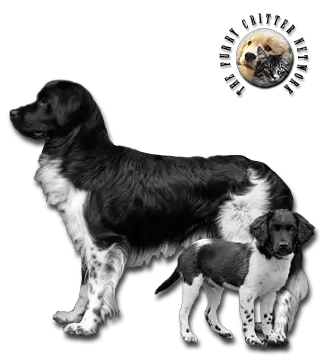Breed Standard
Head: Chiseled, longer than it is wide. Slightly domed skull. Moderate stop. Straight nosebridge. Powerful muzzle, equal in length to skull. Nose wide, black or brown, depending on coat color. Lips not pendulous.
Ears: Set on low, medium in length, hanging close to the head without twisting. Hair fairly long near the base, shorter toward the tip.
Eyes: Medium in size, round, dark brown in black-coated variety and light brown in brown-coated variety.
Body: Powerful, rectangular build. Short, round neck without dewlap. Chest wider than it is deep, such that forelegs are spread fairly widely apart. Well-sprung ribs. Moderate tuck-up. Straight, fairly long back. Croup nearly level.
Tail: Long, reaching the hock, carried low with the last third curving loosely upward. Covered with long hair.
Hair: Long and flat on the trunk, slightly wavy on the croup. Short on the head. Thick on the backs of the legs.
Coat: Black, brown, or orange with white markings. Spotting and mixing of colors is allowed in the white areas.
Size: Approx. 50 cm (20 in).
Weight: 15 to 20 kg (33-44 lb).
History
The Stabyhoun is a gundog that is first described in the early 1800s. In earlier days it was used for hunting foxes, small game, and birds. While on farms, Stabyhouns exhibited fine skills as a mole-catcher. During the hunting season, it was used as an all-round gundog. Today, the Stabyhoun remains a competent hunter, although British and German breeds are more popular. It is a fine pointer, an excellent tracker, and also a good watchdog. It has also been used as a draught dog.
Historically, these dogs were nearly exclusively owned by farmers, whose limited financial means dictated the need for an all-around working and hunting breed. Due to their versatility, Stabyhouns have been used as a guard dog on farms despite their origins as a gundog. The breed's appearance and purpose have not changed in decades. In earlier days the Stabyhoun was often mixed with another Friesian breed, the Wetterhoun, in order to optimize the traits of these working dogs. However, in 1942 the Stabyhoun received official breed recognition, and crossbreeding between the Stabyhoun and Wetterhoun has ceased.
Today the Stabyhoun enjoys a small but thoroughly devoted following among Dutch sportsmen and homeowners. Its numbers are increasing slowly but steadily. This breed has caught the attention of dog lovers in the United Kingdom, Scandinavia and North America.
Behavior
The Stabyhoun is known for its gentle disposition. This breed is friendly, sensitive, intelligent, calm, patient, and biddable but may be stubborn on occasion. The Stabyhoun is extremely tolerant of children and other animals. With steady yet gentle training, this breed will be obedient and devoted to its guardian. Stabyhouns should never be vicious or snappy.
Although a Stabyhoun can be very calm indoors, like all sporting breeds, it enjoys plenty of physical activity. Given their Frisian roots, Stabyhouns relish the opportunity to swim.
Function
Historically, the Stabyhoun was an all-around working farm dog. Apart from hunting, these dogs were used to guard property and to catch pests such as rats, moles, and polecats. This versatility is still evident in the breed today. Due to the Stabij being a canine jack-of-all-trades, it has not attracted the attention of hobbyists looking to pursue a certain sport or activity.
The Stabyhoun is both a soft-mouthed retriever and pointer with a strong tracking abilities. It works very well in water, not shying away from frigid rivers or lakes, and is easily controlled over greater distances. It retrieves any game alive and undamaged. Despite its more modest build, it is a powerful and sturdy dog, with larger Stabyhouns historically used to pull dog-carts when need arose.
The Stabyhoun is now used in almost all types of dog trials and activities: dog agility, obedience, hunting, triathlon, endurance, and frisbee, amongst others.
Due to the limited size of the Stabyhoun population, careful breeding is essential. The Dutch Association for Stabyhouns and Wetterhouns (Nederlandse Vereniging voor Stabij- en Wetterhounen/NVSW), the Ameri-Can Stabyhoun Association, and the UK Stabyhoun Association have breed advisors who research and approve pairings. In an effort to control inbreeding, the association keeps breeding to a minimum and carefully considers prospective matches. Despite there being modest Stabij populations outside of the Netherlands, the breeding population is small, and the greatest genetic diversity remains in the Netherlands. Since Stabyhouns represent Dutch–in particular, Frisian–culture and heritage, breeders keep puppy and dog prices affordable; Stabyhoun breeders are commonly hobby breeders as a result.
Bitches may deliver no more than five litters in their lifetime. They may be bred only between the age of 18 months and nine years and be rested at least one year between litters. The average Stabyhoun litter size is seven. The hips of prospective mating pairs must be x-rayed (not below a FCI-C result), and the match between bitch and stud has to be approved by the Dutch Club's breeding committee. A stud must be 18 months of age or older to breed, and it must have with the same show and hip results as its female mate. Stud dogs are not to sire more than three litters a year or more than ten in their lifetime. Stud owners are expected to attend breeders' days so that the dogs may be evaluated and paired with potential mates.
Health
A relatively healthy breed with no common health issues at present, the average life span of a Stabyhoun is 13-15 years. Diet, exercise, care, and environment are the factors that most impact the breed's health and lifespan.
Known congenital health conditions in the breed are patent ductus arteriosus (PDA), epilepsy, elbow dysplasia, hip dysplasia, and Type 1 Von Willebrands Disease (vWB). Other conditions recorded are radius curvus, hereditary cataracts, steroid responsive meningitis-arteritis (SRMA), and non-specific cancer. The heritability of these conditions is unknown, but with careful breeding, most of these problems have been eliminated. Epilepsy used to be more prevalent but is no longer as common.






